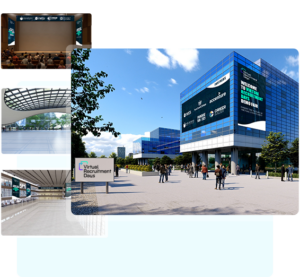When pandemic broke out, everything was shut down and going virtual was the only way to keep in touch. At that time, virtual or hybrid events greatly helped people to keep their life on track at a professional and personal level. Going virtual was never planned. Therefore, in the beginning, it was weird and difficult to adjust in. Gradually with time, we became habitual to digital engagements and started enjoying online networking. While using these ways of working, we also got to know about the impacts of hybrid events and virtual meetings on the environment. They made us learn how these events are environmentally responsible and helps in lowering waste reduction and energy consumption. Thus, it proves eco-friendly event planning is important in making a greener planet to live on.
COVID-19 pandemic
It was unfortunate that we witnessed this pandemic and became victims. But life goes on; we fought and learnt from the battle, and it taught us many things. Out of them, we learnt more to use digital tools to interact with people and audience. As, the pandemic accelerated the shift from in person meetings or gatherings to going more virtual events and meetings. And made them a new normal way of connecting with the world.
1. Hybrid and virtual meetings- a new normal way of connecting.
Before the pandemic gatherings, physical meetings and conferences had mostly become a part of the daily routine of our life. Due to pandemic, this routine was forced to change, and we had to adopt the new normal life. Using online platforms to interact, virtual shows, virtual webinars, virtual exhibitions and virtual trade shows were mainly becoming more popular to interact and provide information. Using such platforms was not the choice but to keep going they became essential. And they need to keep the economy of any organization or any nation alive.
Besides the personal and professional growth, the missed highlights were how these virtual events and meetings have been impacting the environment. Initially, everyone has focused more on the ways of interactions. But when we look back there is a lot that has changed. A conducted study found that virtual meetings and events have been greatly helping in reducing the carbon footprints and making our planet greener.
Learn more about sustainable events and meetings
Why virtual events and hybrid meetings are more sustainable than physical events:
-
- Virtual conferences- lacerate the carbon footprint and energy use by around 94% and 90% respectively, as compared to in- person events.
-
- Hybrid conferences- carefully chosen hub locations will help in reducing the emissions by two-thirds while keeping more than half of the event in-person.
-
- Also, adopting plant-based diets and energy efficiency in technology can further aid in lowering the carbon footprint of virtual conferences.
Further, we will talk briefly about very popular platforms that made people’ lives easier during the pandemic times.
2. Some popular apps or platforms and their carbon footprints on the environment
Some apps or platforms became more popular among people during the pandemic. People were more dependent on them to stay connected and make online connections . These are Zoom, Twitter, Facebook, Netflix, WhatsApp and TikTok. Each app has different features and is used for different purposes. For instance, zoom is more used at a professional level. While Facebook and TikTok platforms are used more for making connections with the audience and staying connected. Likewise, each platform has its own environmental footprint. Netflix is the most used platform and has the highest impact on the environment in terms of carbon footprint, land and water footprint followed by Zoom platform.
2.1 Below is the picture illustrating different platforms and their respective carbon footprints.
In our increasingly digital world, several innovative apps can help individuals and organizations track and reduce their carbon footprints on the environment.

In what ways Virtual Events and Hybrid meetings are Creating a greener impact.
“Effective event planning in today’s digital landscape requires a strategic approach to virtual events and hybrid meetings, seamlessly blending technology and engagement to create memorable experiences while minimizing environmental impact.”, No doubt virtual events and hybrid meetings are greatly helping our environment to be eco- friendly in various ways. The below explained values highlight how they are making our planet greener and healthier.
1. Reduced Travel Emissions
Global Accessibility: attendees from different nations or locations can join the meetings or events without using any flights or long hours driving which help in reducing the co2 emission in the environment.
Less Travel: with the help of virtual events and meetings participants need to travel less, which significantly lowers carbon footprints.
2. Lower Venue Energy Use
Minimal Resources: virtual or hybrid events require less space than in person meetings or events which impact directly or indirectly positively on the environment.
Reduced Facilities: Virtual events require no physical venues, which means no energy consumption for heating, cooling, or lighting large spaces.
3. Waste Reduction:
Less Material Waste: Physical events often generate waste from badges, brochures, and promotional materials. Virtual events can provide digital alternatives, drastically cutting down on paper and plastic waste.
Catering Waste: In-person events often involve food and beverage waste. Virtual events eliminate this issue, while hybrid models can minimize catering needs by offering smaller meal options.
4. Reduced Resource Consumption
Streamlined Operations: Fewer physical materials and resources required for the setups, registration, and other logistical aspects, leading to a decrease in overall resource consumption.
5. Sustainable Technology Use
Recording and Reusability: virtual events and meetings can be recorded, and they can be used again and again resulting in reducing the low energy consumption by reducing the need for repetitive live events.
Efficient Platforms: Many virtual platforms are optimized for low energy consumption, especially when utilizing cloud services that prioritize sustainability.
6. Promoting Sustainable Practices
Offsetting Options: Hybrid events and virtual meetings can include carbon offset programs which allows the participants to contribute to making sustainable efforts.
Green Initiatives: Organizers can encourage digital interactions and promote sustainability tips throughout virtual events, fostering a culture of environmental responsibility.
7. Easier Measurement and Improvement
Data Insights: Virtual platforms provide analytics that can help organizers in measuring and collecting the real time data in no time. Also, it helps in measuring the impact on the environment easier. Besides, identify all the areas which need improvement in future events. Here you can read more about the sustainable events.

How we can harness more Eco-Friendly Event Planning
Harnessing more eco-friendly event planning involves adopting sustainable practices throughout the entire event lifecycle. Here are some effective strategies that can help in making eco-friendly event planning.
Education- it is one of the important ways to spread awareness and to promote sustainability. By educating the participants, it helps them in getting inspired so that they can choose eco-friendly options. And consider hybrid meetings and virtual events as a part of their lives.
Technology– by employing energy efficient and low-emission video conferencing systems for virtual events and hybrid meetings results in making eco-friendly environment.
Carbon offsetting- considering and investing in the carbon offset projects can greatly help in reducing the carbon or counterbalance the emissions that cannot be eliminated. Read more about Carbon Offset Programs: carbonfootprint.com
Communication: digital communication is the best way for event promotion and the materials. Using electronic ticketing and programs can aid in minimizing paper usage.
Conclusion
This blog focused on the role of virtual or hybrid events in making a greener planet. In this, it is discussed that before pandemic virtual platforms were not our priority to make things happen. But the situation demanded that we had to adapt into the new normal life and made virtual or hybrid events a part of our lives. This blog covers the different types of virtual platforms and their carbon footprints on the environment. Besides, it highlighted and explained many important ways that aid in making our planet safer and greener to live on. Followed by how with the help of education, technology, communication can make people aware and promote sustainability.
Moreover, as we know the world becomes increasingly aware of the need for sustainable practices, virtual and hybrid events present a powerful opportunity for the events industry to lead the charge. By embracing these formats, planners can create engaging experiences while significantly reducing their environmental impact. The shift towards eco-friendly event planning is not just a trend; it’s a necessary evolution that will shape the future of gatherings. Let’s harness the power of technology to build a greener, more sustainable planet—one event at a time.
Are you interested in seeing how a virtual event could look like?
Please check our case study : virtual career fair
Author : Sneha Kaushik






